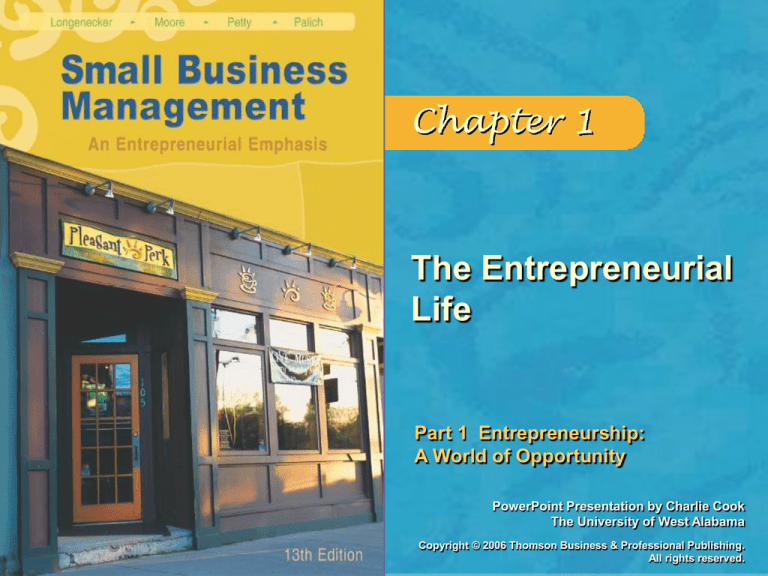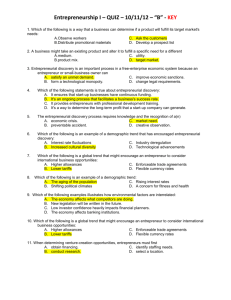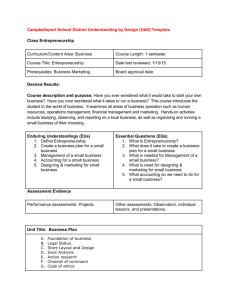
The Entrepreneurial
Life
Part 1 Entrepreneurship:
A World of Opportunity
PowerPoint Presentation by Charlie Cook
The University of West Alabama
Copyright © 2006 Thomson Business & Professional Publishing.
All rights reserved.
Looking Ahead
After studying this chapter, you should be able to:
1.
Discuss the availability of entrepreneurial opportunities and give
examples of successful businesses started by entrepreneurs.
2.
Explain the nature of entrepreneurship and how it is related to
small business.
3.
Identify some motivators or rewards of entrepreneurial careers.
4.
Describe the various types of entrepreneurs and entrepreneurial
ventures.
5.
Identify five potential advantages of small entrepreneurial firms.
6.
Discuss factors related to readiness for entrepreneurship and
getting started in an entrepreneurial career.
7.
Explain the concept of an entrepreneurial legacy and the
challenges involved in crafting a worthy legacy.
Copyright © 2006 Thomson Business & Professional Publishing. All rights reserved.
Student 1–2
Entrepreneurial Opportunity and Success
• An entrepreneurial opportunity is a desirable and timely
innovation that creates value for interested buyers and
end users.
• Exciting entrepreneurial opportunities exist for those who
recognize them.
• However, a true opportunity exists only for those who
have the interest, resources, and capabilities required to
succeed.
• SLR Contracting and Service Company, FlavorX, and
Auntie Anne’s are examples of highly successful
businesses started by entrepreneurs.
Copyright © 2006 Thomson Business & Professional Publishing. All rights reserved.
Student 1–3
Entrepreneurial Firms
• Entrepreneurs are individuals who discover market
needs and launch new firms to meet those needs.
• Owner-managers who buy out founders of existing firms,
franchisees, and second-generation operators of family
firms may also be considered entrepreneurs.
• Definitions of small business are arbitrary, but this book
focuses on firms of fewer than 100 employees that have
mostly localized operations and are financed by a small
number of individuals.
• Most entrepreneurial firms are small when they begin,
but a few grow (some very quickly) into large
businesses.
Copyright © 2006 Thomson Business & Professional Publishing. All rights reserved.
Student 1–4
Why People Become Entrepreneurs
• Researchers have identified up to 38 different reasons
for self-employment.
• Entrepreneurial motivators or rewards include profit,
independence, freedom (escaping from a bad situation),
personal satisfaction, and personal fulfillment
(contributing to one’s community).
Copyright © 2006 Thomson Business & Professional Publishing. All rights reserved.
Student 1–5
Types of Entrepreneurs
• Founders of firms are “pure” entrepreneurs, but those
who acquire established businesses and franchisees
may also be considered entrepreneurs.
• A few entrepreneurs start high-potential ventures
(gazelles); other entrepreneurs operate attractive small
firms and microbusinesses.
• Entrepreneurial teams consist of two or more individuals
who combine their efforts to function as entrepreneurs.
• Based on their backgrounds and management styles,
entrepreneurs may be characterized as artisan
entrepreneurs or opportunistic entrepreneurs.
• The number of women entrepreneurs is growing rapidly,
and they are entering many nontraditional fields.
Copyright © 2006 Thomson Business & Professional Publishing. All rights reserved.
Student 1–6
Advantages of Entrepreneurial Firms
• Entrepreneurial managers get to know their customers
well which helps them focus on meeting their needs.
• By emphasizing quality in products and services, small
firms can build a competitive advantage.
• Independent business owners can build a culture of
integrity and responsibility that strengthen the firm’s
position in a competitive environment.
• Many small firms and operators have a superior talent
for finding innovative products and developing better
ways of doing business.
• Small firms that find a special niche of some type can
gain an advantage in the marketplace.
Copyright © 2006 Thomson Business & Professional Publishing. All rights reserved.
Student 1–7
Who Are Entrepreneurs?
• The period between the mid-20s and mid-30s appears to be when a
person’s education, work experience, family situation, and financial
resources are most likely to enable him or her to become an
entrepreneur.
• There is no well-defined entrepreneurial profile, but many
entrepreneurs have such helpful characteristics as a passion for
their business, strong self-confidence, and a willingness to assume
moderate risks.
• Successful entrepreneurs are also thought to possess leadership
skills, a strong focus on opportunities, creativity and adaptability,
and motivation to excel.
• Entry into entrepreneurial careers is often triggered by a
precipitating event, such as losing a job.
• Once a business is launched, the entrepreneur must manage
growth of the business and issues related to its ongoing operation.
Copyright © 2006 Thomson Business & Professional Publishing. All rights reserved.
Student 1–8
The Rewards of Entrepreneurship
• An entrepreneur’s legacy includes not only money and
material possessions but also nonmaterial things such
as personal relationships and values.
• Part of the legacy is the contribution of the business to
the community.
• A worthy legacy includes a good balance of values and
principles important to the entrepreneur.
• Errors in choosing or applying goals and values can
create a defective legacy.
• Building a legacy is an ongoing process that begins at
the launch of the firm and continues throughout its
operating life.
Copyright © 2006 Thomson Business & Professional Publishing. All rights reserved.
Student 1–9
Key Terms
entrepreneurial opportunity
microbusiness
entrepreneur
lifestyle business
reluctant entrepreneur
entrepreneurial team
refugee
artisan entrepreneur
founder
opportunistic entrepreneur
franchisee
internal locus of control
high-potential venture
(gazelle)
external locus of control
attractive small firm
precipitating event
entrepreneurial legacy
Copyright © 2006 Thomson Business & Professional Publishing. All rights reserved.
Student 1–10






